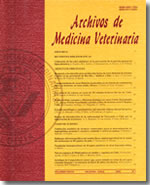Characterisation of behavioural reactivity in steers during handling and its relationship with blood Cortisol, bruising and meat pH
Main Article Content
Abstract
In order to explore the capacity of behavioural tests to predict the incidence of high pH meat (dark cutting) in commercial setting, we assessed the relationship between behavioural reactivity, physiological parameters and meat quality in steers. Fourty-two steers were weighed individually in a scale (2.5x3x2.5m) to assess two behavioural parameters: crush test and exit velocity. Repeatability of the behavioural responses during 3 weighing events was calculated and a consistency scale was created to determine consistency of the parameters. Blood samples were collected from each steer after the second crush test and at bleeding, then analyzed for serum cortisol. Bruising and pH were registered after slaughter on the carcasses. Crush score was highly consistent (r = 0.81-0.87) and exit velocity moderately consistent (r = 0.44-0.60), however individual differences were detected in the "acclimation" and "sensitization" to the test through time. Higher crush score was associated with higher on farm cortisol concentration. Steers producing carcasses with multiple bruises (3-4) had a higher serum cortisol concentration at bleeding (P < 0.05) than steers with less carcass bruising. Behavioural parameters, carcass bruising and meat pH were not statistically associated. We conclude that it is important to evaluate behavioural reactivity using serial tests and we recommend further exploration on the capacity of reactivity tests to detect differences in reactivity that can be reflected in differences in meat quality parameters.

